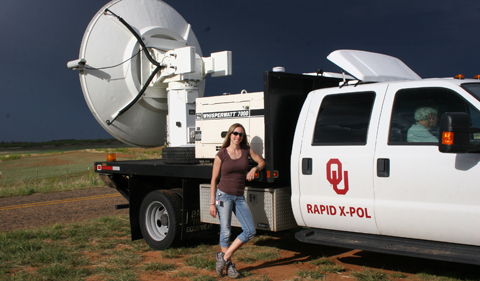Tornadoes form fast—in just one to two minutes—and meteorologists don’t always know which storms will produce them. Forecasters use radar systems in fixed locations that scan the environment at a slower rate than tornadoes develop.
Dr. Jana Houser, Associate Professor of Geography at Ohio University, and colleagues at the University of Oklahoma now are finding more detailed data on how tornadoes form through the use of mobile radar technology. By mounting a rapid scan radar to a truck, researchers can collect data every two seconds—getting full reports every 30 seconds, compared with every two to four minutes in a traditional system, she explained.

Dr. Jana Houser with University of Oklahoma’s Rapid-scan, X-band, polarimetric mobile radar (RaXPol).
Analyzing data from the rapid scan system, Houser and her colleagues recently provided new observational evidence for one of the two main theories of tornado formation: tornadoes can develop from the bottom up. The traditional explanation is that tornadoes form from the clouds down. The scientists observed that the storm first must have a strong rotation near the ground surface, and then rapidly extend upward, to create a tornado. The findings made national news headlines in 2019.
While the mobile radar technology currently is being used only for research, not weather forecasting, Houser hopes it will open the door to new developments that eventually will aid meteorologists. The scientist also organizes educational field trips for Ohio University students each spring to teach these future meteorologists about the challenges of tracking and predicting storms in the field.

















Comments